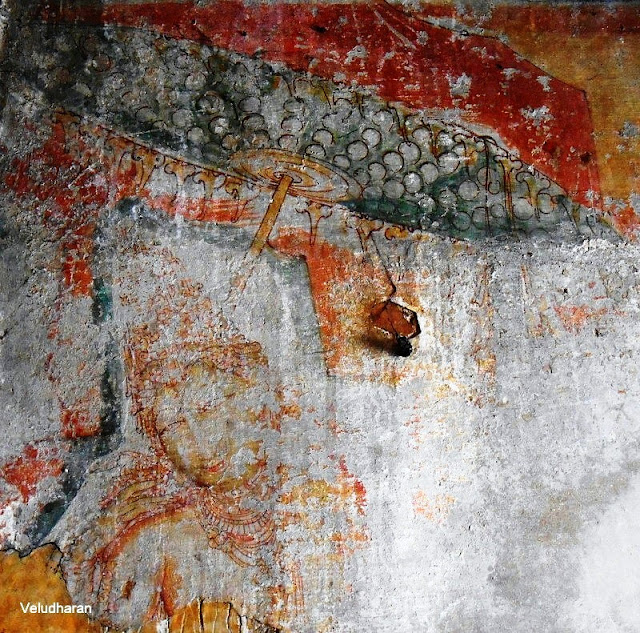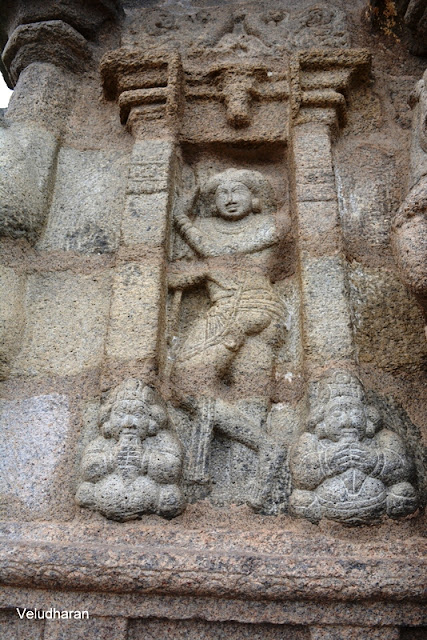....a Continuation post to Mandakapattu Rock cut Cave Temple
23rd July 2017.
This
is the second masonry temple built after Mahabalipuram shore temple, during 8th century
by Narasimhavarman–II also known as Rajasimhan ( 706 to 722 CE ) on this small
hill. Steps are built for some stretch and in some stretch, chiseled on the
rock itself. The temple is under the control of Archaeological Survey of India
(ASI).
Moolavar
: Sri Talagiresvara
Consort
: Sri Ashtatalambigai
Some
of the salient features of this temple are,...
At
the entrance of the hill a Vinayagar temple with a relief on the boulder. Durgai
is in a samall cave on the left side of the base ( Durgai is with ashta bhujam
holding Thandas, bow, Sangu, shield, Kadi hastam, Chakra, Sword and Kadaka
mudra ). The temple is facing east with
Rishabam and Balipeedam. There are 3 koshtams in which 8 faces Dara linga is
installed. Moolavar is also Dara lingam with 16 faces. Somaskandar relief is on
the back side of the sanctum wall. In artha mandapam reliefs of Mahavishnu with
Lakshmi on the right and Brahma with Saraswati are on the left. Lime mortar is
applied on the images.
In
praharam Sannidhi for Vinayagar, Sri Valli Devasena Subramaniyar, Navagrahas,
Bairavar, Saniswaran, Suryan, Chandran and Ambal is facing south.
In Kostam
The
temple was constructed with sanctum, ardha mandapam and maha mandapam. The
sanctum vimana is of 3 tiers and lime mortar is applied on the images. Of this
the last two tiers are constructed at a latter period.
On
the right side kostam the stone wall was plastered with lime mortar and
Shiva’s oozhi koothu dance was painted ( the same is in the form of stucco
image at Kanchi Sri Kailasanathar Temple ) and the right wall has the
painting of Parvati looking the dance of Shiva. It will be very difficult to
trace now, almost in faded condition.
Adhistanam
HISTORY AND INSCRIPTIONS
This
is the second masonry temple built after Mahabalipuram shore temple, during 8th century
by Narasimhavarman–II also known as Rajasimhan ( 706 to 722 CE ) on this small
hill.
The
pallava grantha / Sanskrit inscriptions ( SII Vol 12- 29 - 30 & Pallava Inscriptions 62 & 63 ) records the
Narasimhavaraman-II’s titles as Rajasimhan, Ranajayan, Sribara, Chitrakarmukha,
Eka vira and Siva soodamani. Also mentions that Pallavas are the decedents of
Bhardwaj, Aswathaman. The inscription mainly records the donation given to this
temple.
The 18th century Arcot Nawab Saddath Ullah khan's inscription records the excavation of a pond on this hill, to get rid of the sin caused due to Killing of Rajadesingh. The inscription records as “Svasthisri Sriman maha
mandaleswara Rajathiraja Rajaparameswara Rajamarthanda Nawab Sadhat Ullah Khan
Saibu… ". The inscription is on the pillar next to Vinayagar Sculpture.
POOJAS & CELEBRATIONS
Apart
from regular oru kala pooja, special poojas are conducted on pradosham,
Pournami, Maha Shivaratri, Aippasi Annabhishekam, Thai Kanum Pongal ( Utsavar
will be taken in procession to 7 Villages ), etc,.
Annual festival is celebrated on Chithirai 1st day
CONTACT DETAILS
Kasi
Sivachariyar may be contacted on his mobile +918056863301
HOW TO REACH
Panamalai
is about 21 KM from Gingee
Since
there is no proper bus service either you can hire Taxi from Gingee or from
Villupuram
LOCATION OF THE TEMPLE :CLICK HERE
.... to be continued Rock Paintings in the
prehistoric shelters between Villupuram to Thirukovilur.
--OM SHIVAYA NAMA---















































